Related Research Articles
Kullu is a district in Himachal Pradesh, India. It borders Rampur district to the south, Mandi and Kangra districts to the west, and the Lahaul and Spiti district to the north and east. The largest valley in this mountainous district is the Kullu Valley. The Kullu valley follows the course of the Beas River, and ranges from an elevation of 833m above sea level at Aut to 3330m above sea level at the Atal Tunnel South Portal, below the Rohtang Pass. The town of Kullu, or simply Kullu, located on the right side of the Beas River, serves as the administrative headquarters of the Kullu district. The Kullu district also incorporates several riverine tributary valleys of the Beas, including those of the Parvati, Sainj, and Tirthan rivers, and thus some regions somewhat distant from the Kullu valley. The economy of the district relies mainly on horticulture, agriculture, tourism, and traditional handicrafts.
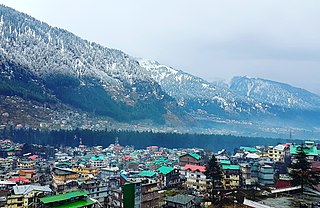
Manali is a town, near Kullu town in Kullu district in the Indian state of Himachal Pradesh. It is situated in the northern end of the Kullu Valley, formed by the Beas River. The town is located in the Kullu district, approximately 270 kilometres (170 mi) north of the state capital of Shimla and 544 kilometres (338 mi) northeast of the national capital of New Delhi. With a population of 8,096 people recorded in the 2011 Indian census Manali is the beginning of an ancient trade route through Lahaul (H.P) and Ladakh, over the Karakoram Pass and onto Yarkand and Hotan in the Tarim Basin of China. Manali is a popular tourist destination in India and serves as the gateway to the Lahaul and Spiti district as well as the city of Leh in Ladakh.

Begusarai District is one of the thirty-eight districts of the Indian state of Bihar. The city of Begusarai is its administrative headquarters and is part of the Munger division.
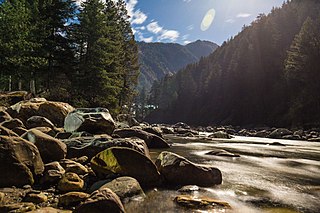
Parvati River is a river in the Parvati Valley in Himachal Pradesh, northern India that flows into the Beas River at Bhuntar, some 10 km south of Kullu. It rises from the Man Talai Glacier below the Pin Parbati Pass and flows in a gradual curve from north-northwest to west-southwest past the important temple town of Manikaran.

Kullu is a municipal council town that serves as the administrative headquarters of the Kullu district of the Indian state of Himachal Pradesh. It is located on the banks of the Beas River in the Kullu Valley about 10 kilometres (6.2 mi) north of the airport at Bhuntar, Kullu.
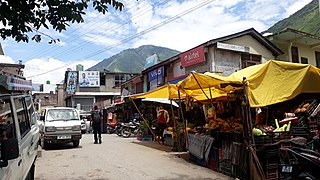
Bhuntar is a town and a nagar panchayat in Kullu district in the state of Himachal Pradesh, India. It is just 11 km from Kullu town, and lies along National Highway 3. The Kullu Airport is located in Bhuntar. Bhuntar is located on the right bank of the Beas River. Right opposite to Bhuntar, near the left bank of the Beas River, there is the confluence of the Parvati River with the River Beas. The Parvati Valley begins at this confluence and runs eastward, through a steep-sided valley towards Kasol and Manikaran.

Renuka lake is in the Sirmaur district of Himachal Pradesh in India and it is 672 m above the sea level. It is the largest lake in Himachal Pradesh, with a circumference of about 3214 m. This lake was named after the goddess Renuka and is designated as Ramsar site since November 2005.
The Renuka Sanctuary is a nature sanctuary. It is situated in Sirmour district in Himachal Pradesh and is connected to a network of roads. It covers about 4.028 square kilometres. Also known as Renuka Reserve Forest, it has been formally declared a sanctuary. A further area of roughly about 3 square kilometres that lies outside the sanctuary has been declared as a buffer area.
The Manali Wildlife Sanctuary is a wildlife sanctuary in Himachal Pradesh in northern India. The sanctuary starts about 2 km from Manali. It is the catchment of Manalsu khad. A path from Manali log huts and Dhungri temple passes through dense Deodar, Kail, Horse chestnut, Walnut and Maple forests. Musk deer, Monal and Brown bear, Leopard and Snow leopard are some of the common animals seen here. Herds of Ibex are seen migrating in the glacier zone in summers. The area of the sanctuary is about 31.8 square kilometres. The following area was declared as a sanctuary on 26 February 1954, under the Punjab Birds and Wild Animals Protection Act of 1933.
The Daranghati Sanctuary is located in Rampur Bushahr, Shimla, Himachal Pradesh, India. It has undisturbed forest areas. Monal, Tragopan, Koklas and Kalij are the pheasants found here. Some of the common animals found here are Musk deer, Goral and Thar. Forest staff posted at Dofda and Sarahan is there for advice and guidance.
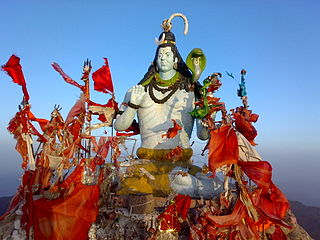
Churdhar Sanctuary is located in Sirmaur district of the Indian state of Himachal Pradesh. The total covered area of this sanctuary is 56.16 square kilometres as notified on 15 November 1985. Fauna includes Himalayan black bear, Barking deer, Musk deer, Langur and Leopards. The work of administration at Churdhar is taken care by Chureshwar Sewa Samiti.
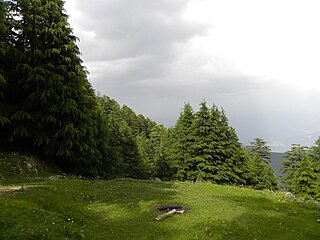
Kalatop Khajjiar Sanctuary, or simply Kalatop Sanctuary, is a 30.69 km² animal sanctuary at Kalatop and Khajjiar in the Chamba district of Himachal Pradesh, India. The sanctuary area is well laid out for trekking trails both at Kalatop and Khajjiar. There is a dense deodar and fir forest covering 19.63 km² of the sanctuary, which is about 6 km from Dalhousie. Pheasants, serow and black bear are some of the common animals found here. The sanctuary lies in the path of the Ravi River, and is surrounded by coniferous and oak forests.
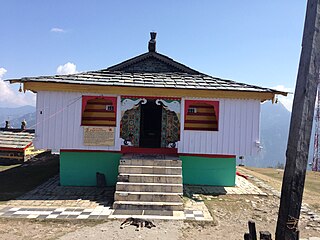
Bijali Mahadeva Mandir is a located in Kashawri village, Kullu Valley in the Indian state of Himachal Pradesh. It is located at an altitude of about 2,460m in the Kullu Valley. Bijli Mahadev is one of the ancient temples in India and dedicated to Lord Shiva (Mahadev). Located 14 km from Kullu across the Beas river, it can be approached by a rewarding trek of 3 km.

The Sar Pass is in Parvati Valley of Kullu district of Himachal Pradesh, a state of India.

Bhrigu Lake or Brighu Lake is a lake located at an elevation of around 4,300 metres (14,100 ft) in Kullu district, Himachal Pradesh, India. It is located to the east of Rohtang Pass and is around 6 kilometres (3.7 mi) from Gulaba village. It can be reached by trekking either from the Vashishth temple, which is famous for its hot water springs, close to the town of Manali. Actually there is no settlement in Gulaba and is an area of the Pir Panjal mountain range. It is named after Maharishi Bhrigu.

Nargu Wildlife Sanctuary lies on the east side of the Uhl River in Mandi District of Himachal Pradesh. It was notified in 1999 and covers an area of 132.37 km2 (51.11 sq mi). The slopes of the sanctuary are covered with Alpine forest. It is home to various species of animals and birds.

Kasol is a hamlet in the Kullu district of the Indian state of Himachal Pradesh. It is situated in Parvati Valley, on the banks of the Parvati River, on the way between Bhuntar and Manikaran. It is located 30 km (19 mi) from Bhuntar and 36 km (22 mi) from Kullu town, the district headquarter, 3.5 km from Manikaran. Kasol is the Himalayan hotspot for backpackers and acts as a base for nearby treks to Malana and Kheerganga. It is called Mini Israel of India due to a high percentage of Israeli tourists here.
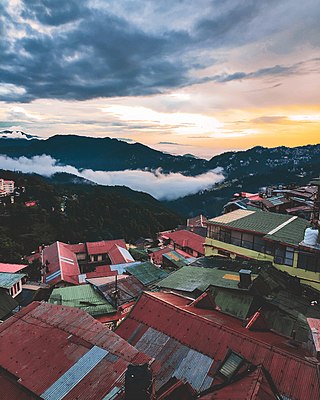
Tourism in Himachal Pradesh relates to tourism in the Indian state of Himachal Pradesh. This is popularly renowned for its Himalayan landscapes and popular hill-stations. Many outdoor activities such as rock climbing, mountain biking, paragliding, ice-skating, trekking, rafting, and heli-skiing are popular tourist attractions in Himachal Pradesh.
Simbalbara National Park is a national park in India, located in the Paonta Valley of Sirmour District, Himachal Pradesh, along its border with Haryana. It is also known as Col. Sher Jung National Park. The vegetation consists of dense Sal forests with grassy glades. The protected area was created in 1958 as the Simbalbara Wildlife Sanctuary with 19.03 km². In 2010, 8.88 km² were added to it and it was made into a National Park, covering an area of about 27.88 square kilometres (10.76 sq mi). There is a perennial stream in the valley. The Travel and Tourism department of Himachal Pradesh has preserved the park in its natural form.
Chanderkhani Pass is a pass located in the Kullu District of India at a height of 3,660 metres. It forms a way (pass) between the villages of Rumsu and Pulag to the well known village of Malana, which indirectly forms a trekking route from Naggar to Malana across the Chanderkhani Pass.
References
- ↑ "himachaltourism.gov.in". Archived from the original on 24 March 2010. Retrieved 13 February 2020.